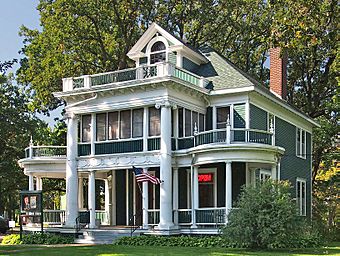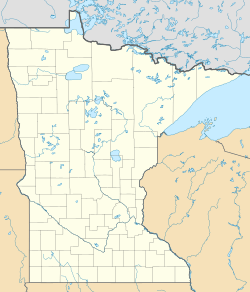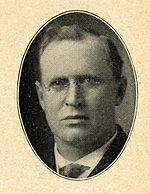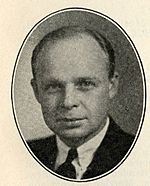Burton-Rosenmeier House facts for kids
Quick facts for kids |
|
|
Burton-Rosenmeier House
|
|

Exterior of the house
|
|
| Location | 606 1st St. SE, Little Falls, Minnesota |
|---|---|
| Area | less than one acre |
| Built | 1903 |
| Architectural style | Neoclassical |
| NRHP reference No. | 86000328 |
| Added to NRHP | March 13, 1986 |
The Burton-Rosenmeier House is an old and important house in Little Falls, Minnesota. It was built in 1903 by a businessman named Barney Burton. This house is special because of its cool design and its interesting past.
On March 13, 1986, the house was added to the National Register of Historic Places. This means it's officially recognized as a place worth protecting. Today, the house is used as the Little Falls Convention and Visitor Center.
Contents
What Does the House Look Like?
The Burton-Rosenmeier House is located on First Street Southeast in Little Falls. It's near other historic areas. The house faces east, and behind it, you can see a ravine and a curved oxbow lake. There's also a small building called a carriage house nearby.
Architectural Style and Features
The house is built in the Classical Revival style. This means it looks a bit like ancient Greek or Roman buildings. It has two stories, plus an attic and a basement. The main part of the house is made of wood. Its base, or foundation, is made of stone. The outside walls are covered with clapboard siding, which are long, thin wooden boards.
The main part of the roof is shaped like a hipped roof (sloping on all sides). Some parts have a gable roof (triangular ends), like over the bay window at the front and an extension at the back. The window frames have decorative tops called cornices. Most windows are double-hung sash windows, which slide up and down. There's also a cool oval window on the south side of the house, near the front door.
The Front Porch
The front of the house has the most eye-catching features. A large porch stretches across the entire front. At each end of the porch, there are round sections called pavilions.
Strong Tuscan columns stand on either side of the front stairs. These columns hold up a flat balcony that sticks out from the house. This balcony has a fancy railing called a balustraded rail. It also acts as a roof for a screened porch on the second story. More columns, called Ionic columns, connect the roofs of the round pavilions. There's even another screened porch on the southwest side of the house, near the kitchen. This one is enclosed with glass.
Who Lived Here? A Look at the House's History
The Burton-Rosenmeier House has been home to two important families: the Burtons and the Rosenmeiers.
Barney Burton: The Builder
Barney Burton was born to Polish immigrants. He first lived in Peoria, Illinois, then moved to Wisconsin. When he was 18, he moved to St. Cloud, Minnesota, and started a clothing business with his brother, Jacob.
In 1886, they moved their business to Little Falls. At that time, Little Falls was growing fast because of the "timber boom" (lots of trees were being cut down for wood). The Burton brothers' business did very well. Barney later became the only owner of the business. His clothing stores grew, selling warm wool clothes to lumberjacks in Central and North Minnesota.
Barney married Sara Deutsch in 1894, but she sadly passed away the next year. In 1898, he married her sister, Josephine. They had three children together. In 1903, the family built this beautiful house in Little Falls. They used a design from a popular architect named George F. Barber. Barney Burton was an important businessman in Little Falls until he died in 1942.
Christian Rosenmeier: Lawyer and Senator
Christian Rosenmeier became a very important person in Morrison County, Minnesota after he finished law school in 1906. He started his own law office. Christian later moved to Little Falls when he was elected as the county attorney.
In 1920, he left that job to focus on his work at American National Bank of Little Falls. The next year, he became the president of the bank. In 1921, the Rosenmeier family bought the Burton house and used it as a law office.
The same year, Christian was elected to the Minnesota State Senate, which is like a state-level government group. He served there until he passed away in 1932. Christian helped make the Charles A. Lindbergh State Park a state park. He also helped create Camp Ripley, a large military training base.
Gordon Rosenmeier: Following in His Father's Footsteps
One of Christian's children, Gordon Rosenmeier, also became a lawyer. He graduated from Stanford University in 1932. Gordon came back to Minnesota and joined his father's law office, which was still in the former Burton house.
Just like his father, Gordon was elected to the state Senate in 1940. He joined the United States Navy in 1942. Even while he was in the Navy, he won his Senate seat again in 1944. He continued to serve in the Senate until 1971. Gordon was still living in the house when it became a registered Historic Place in 1986.





